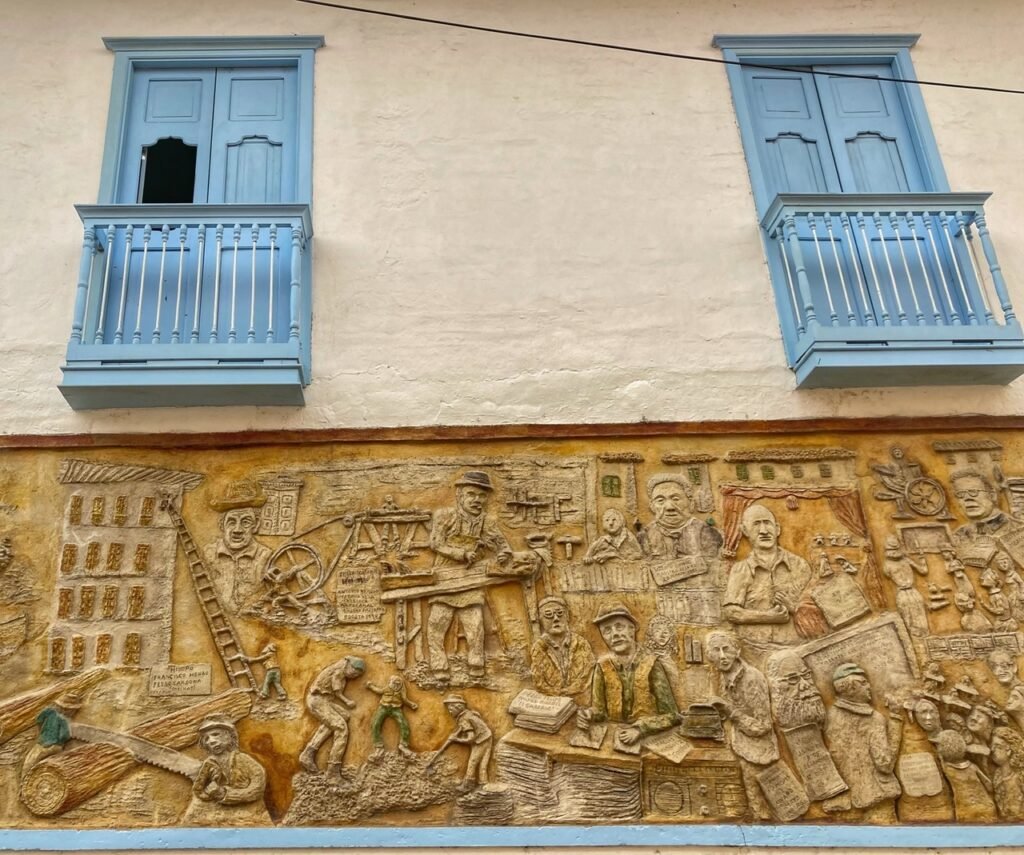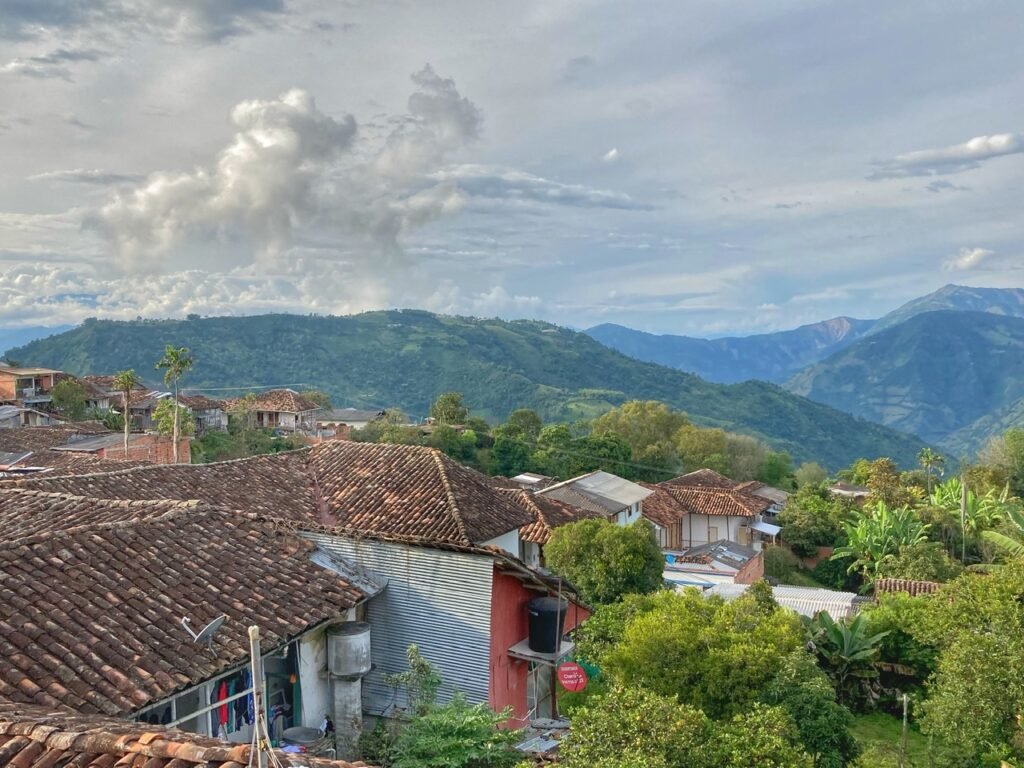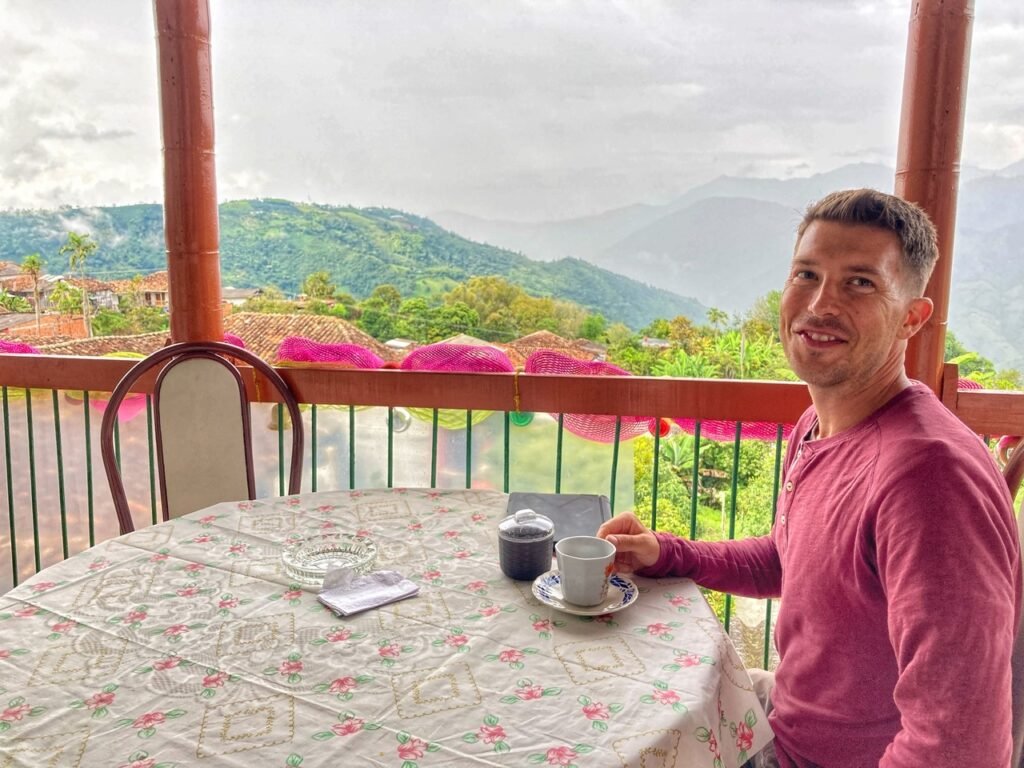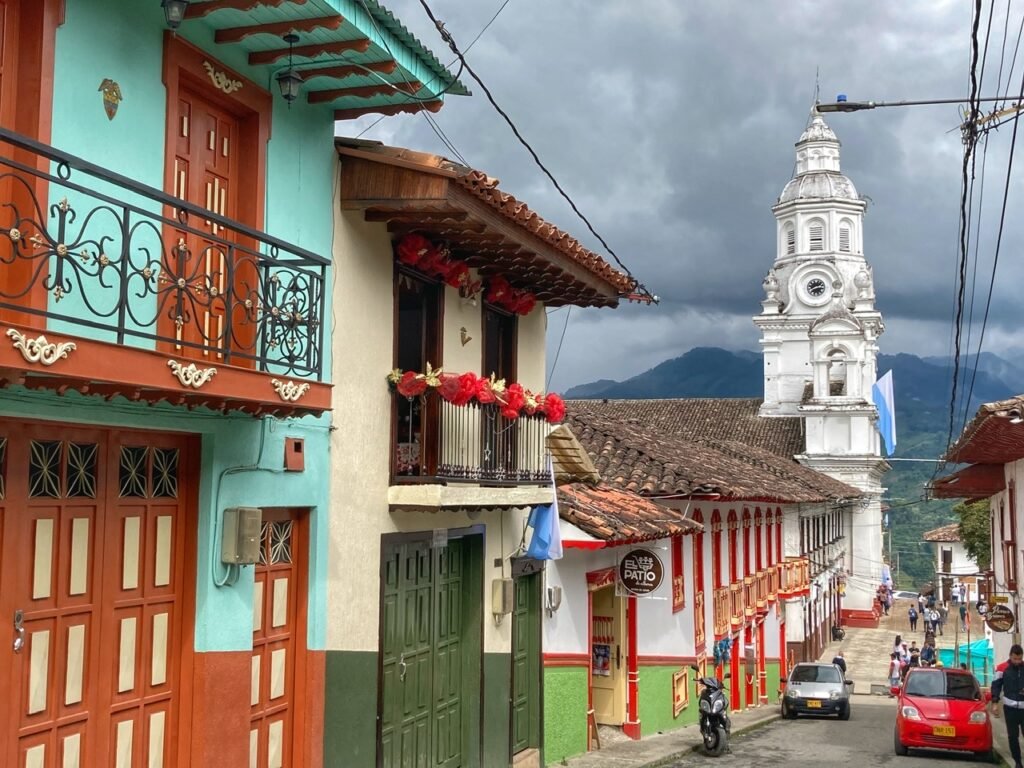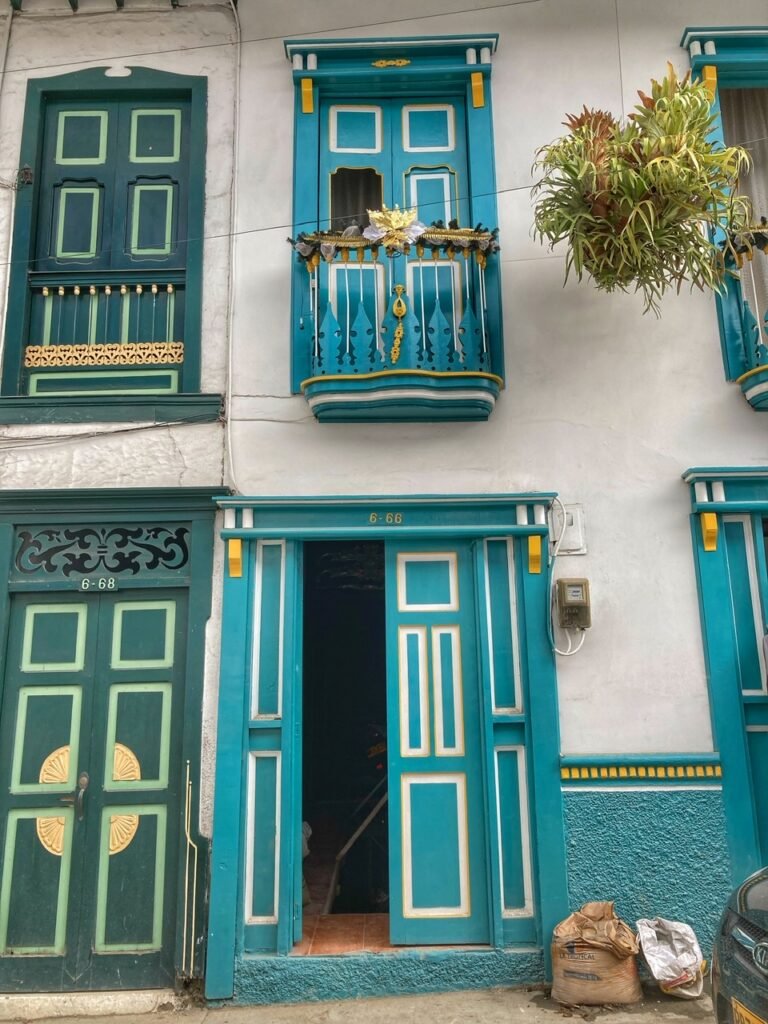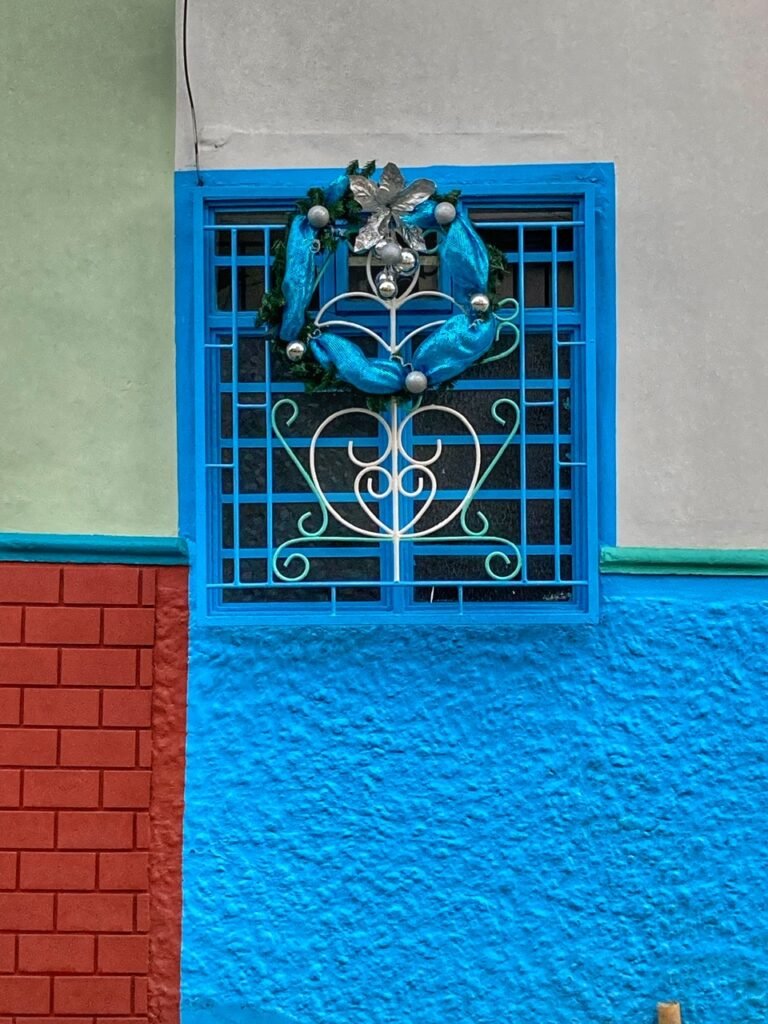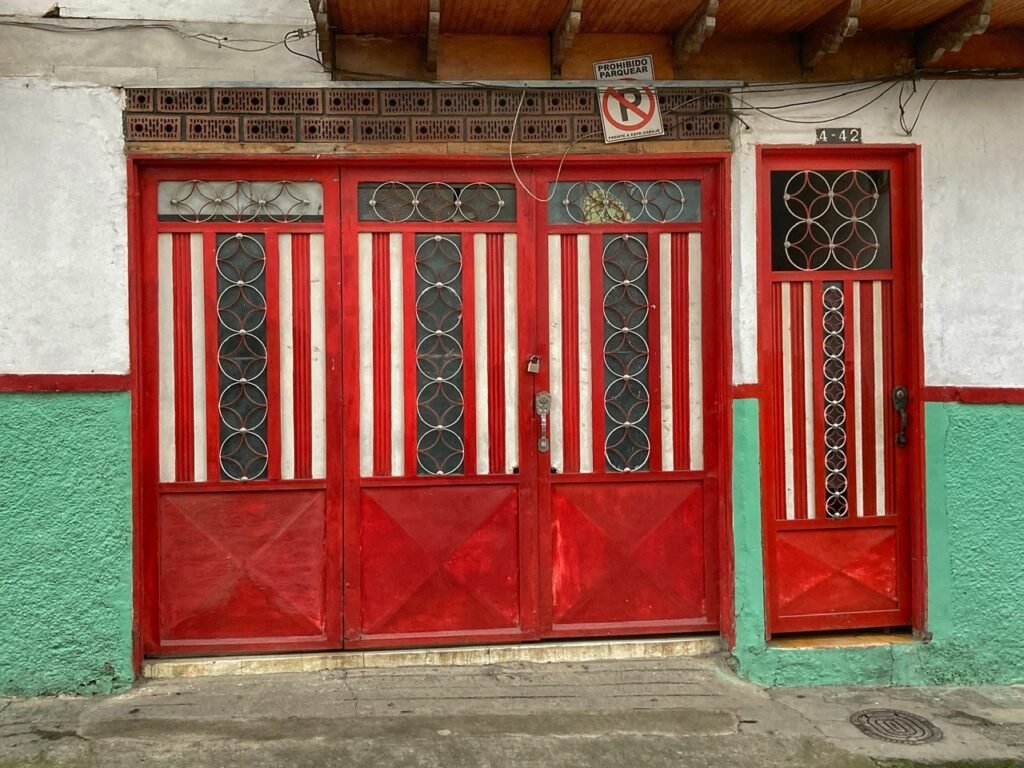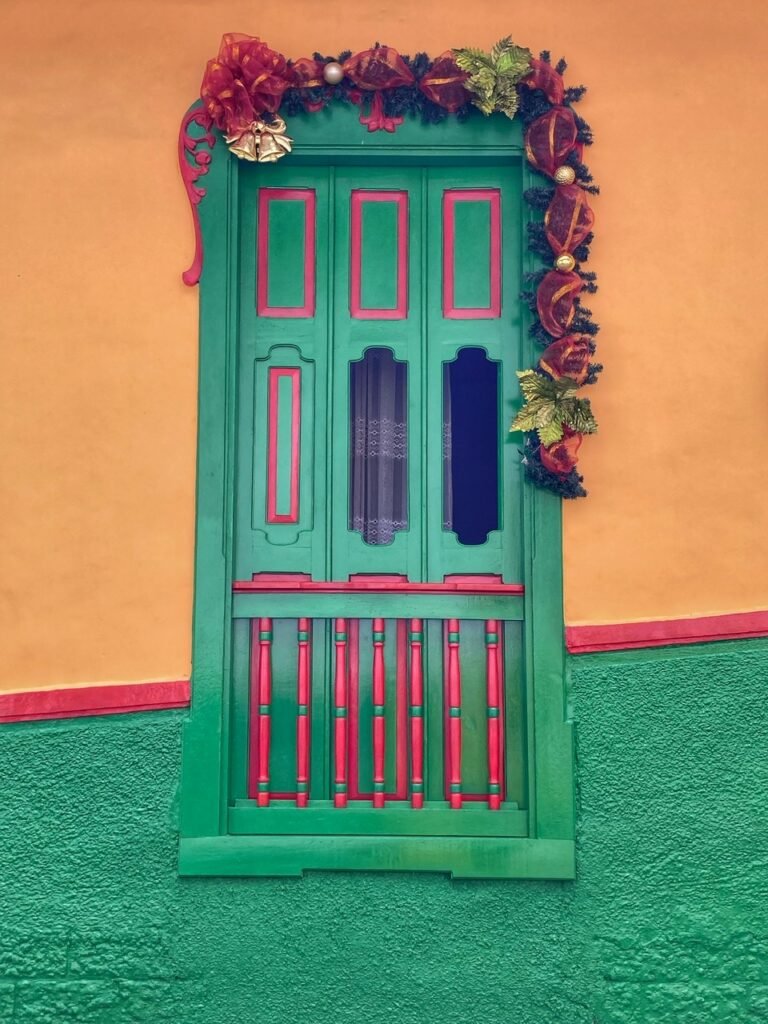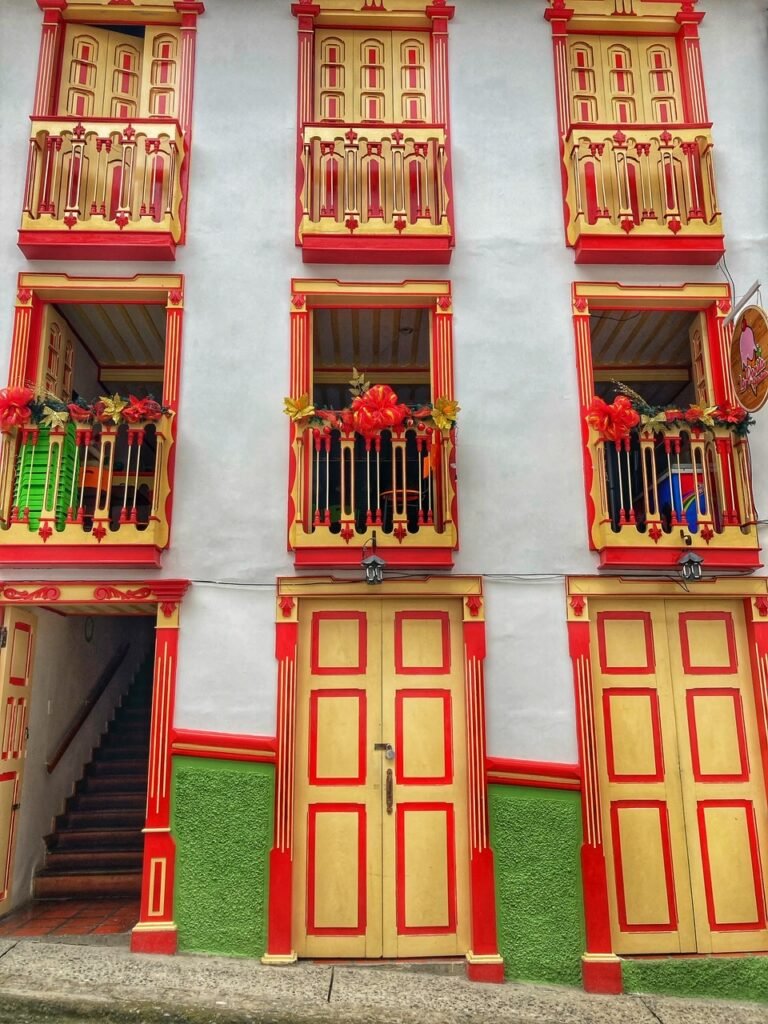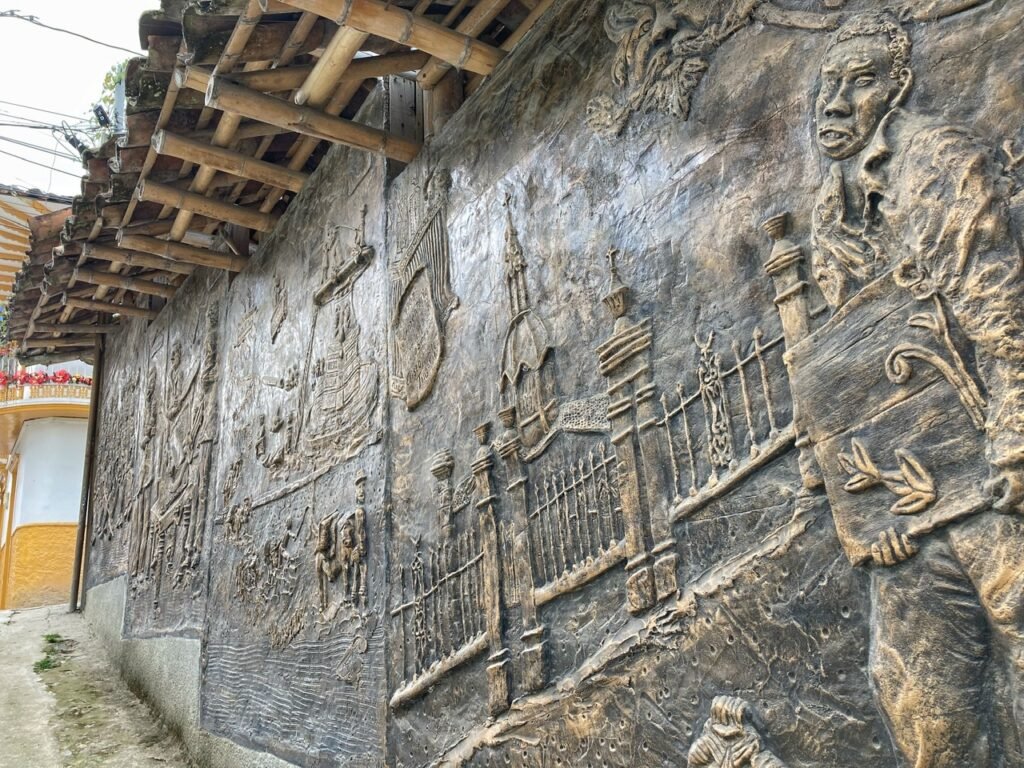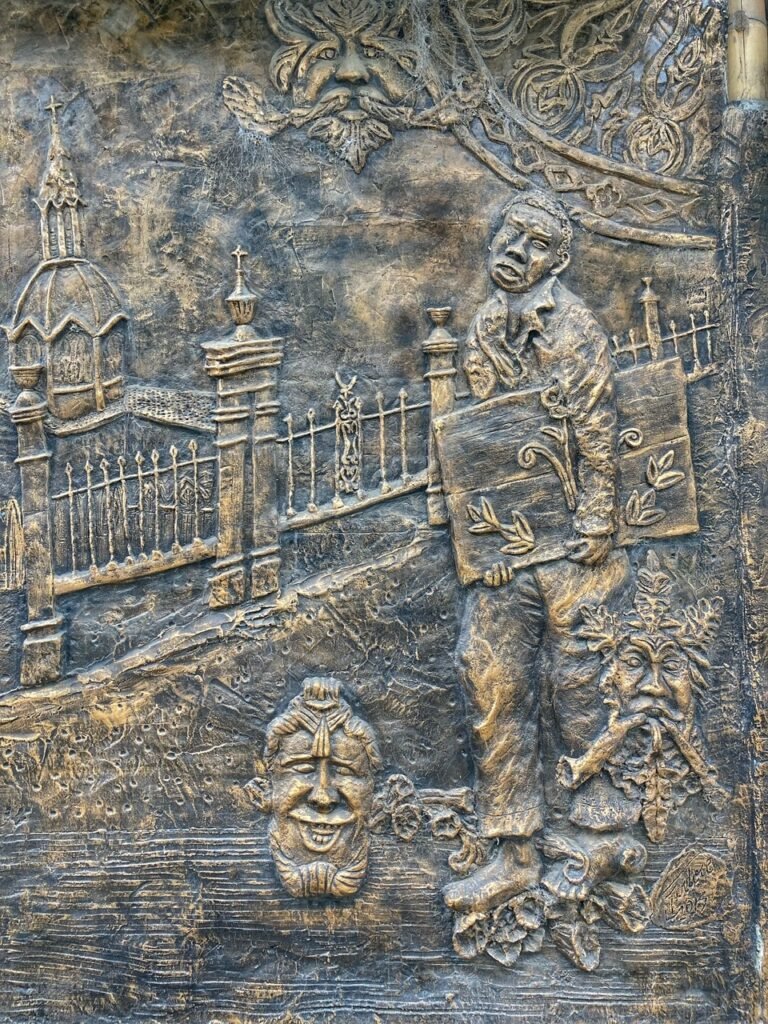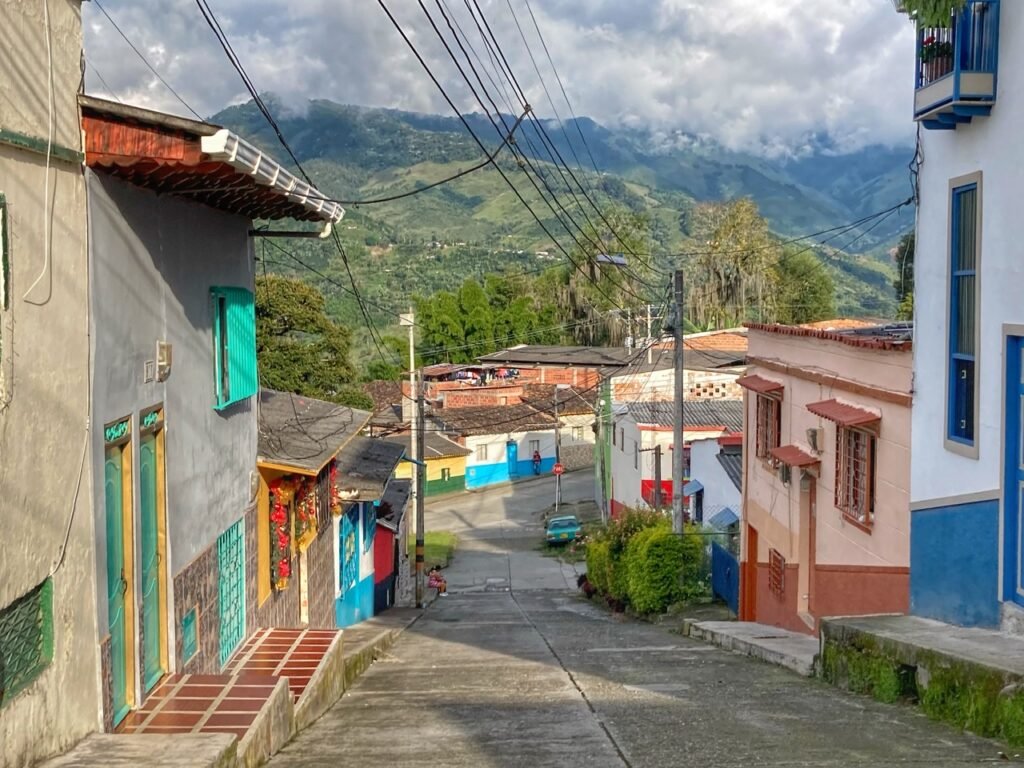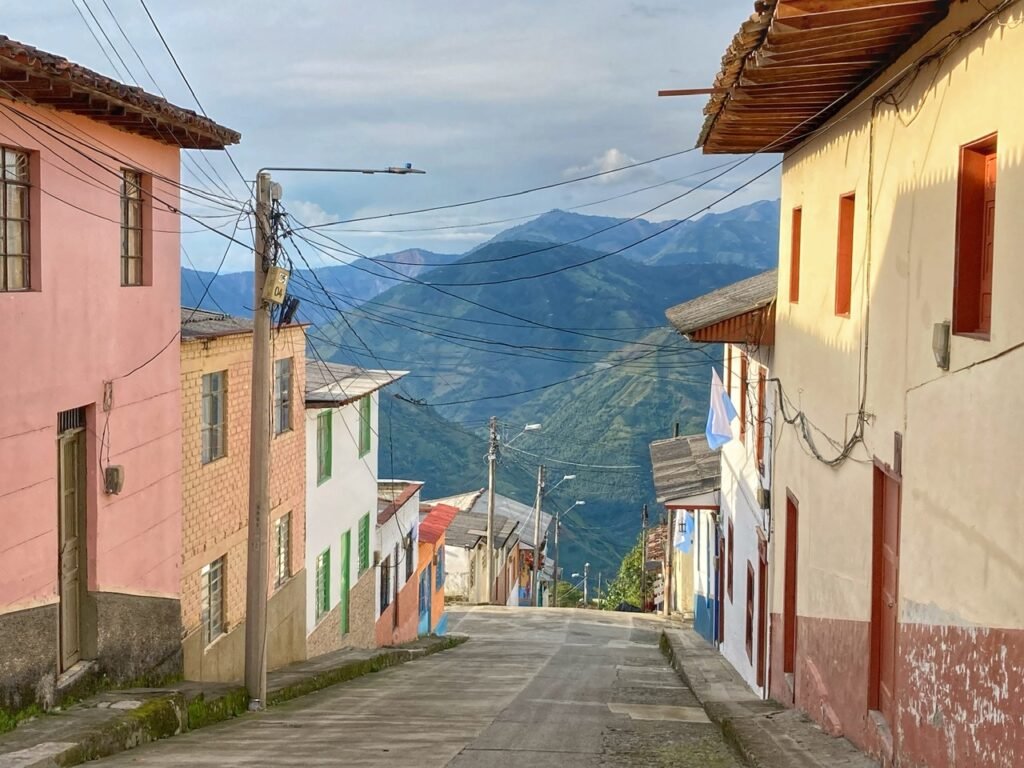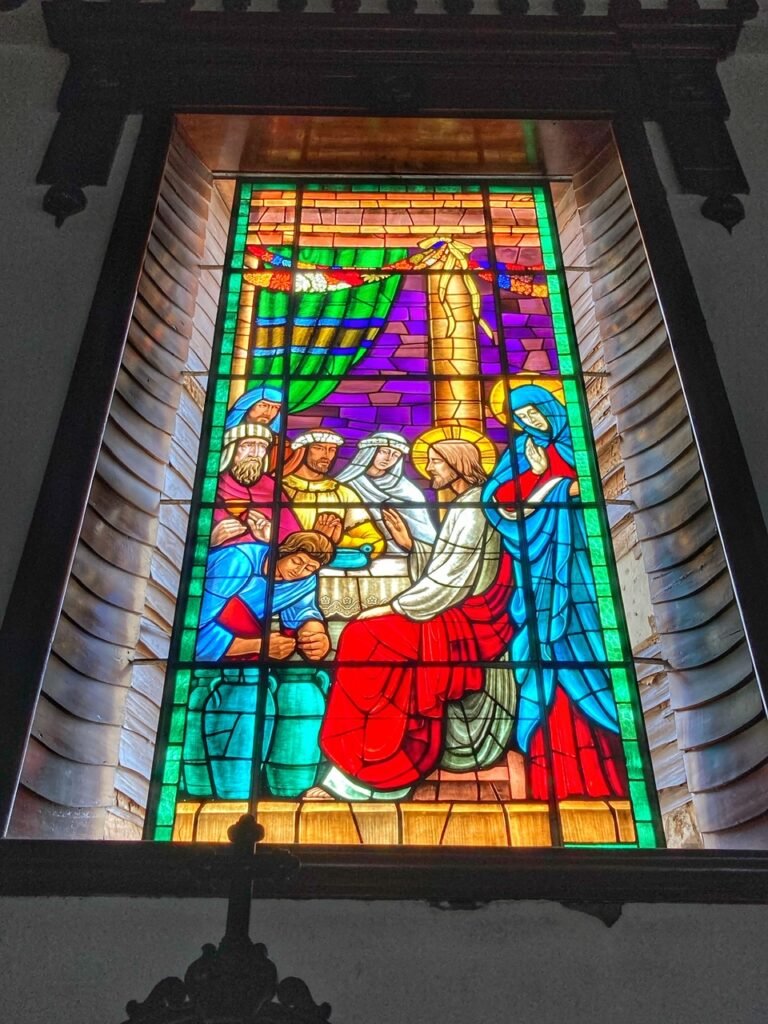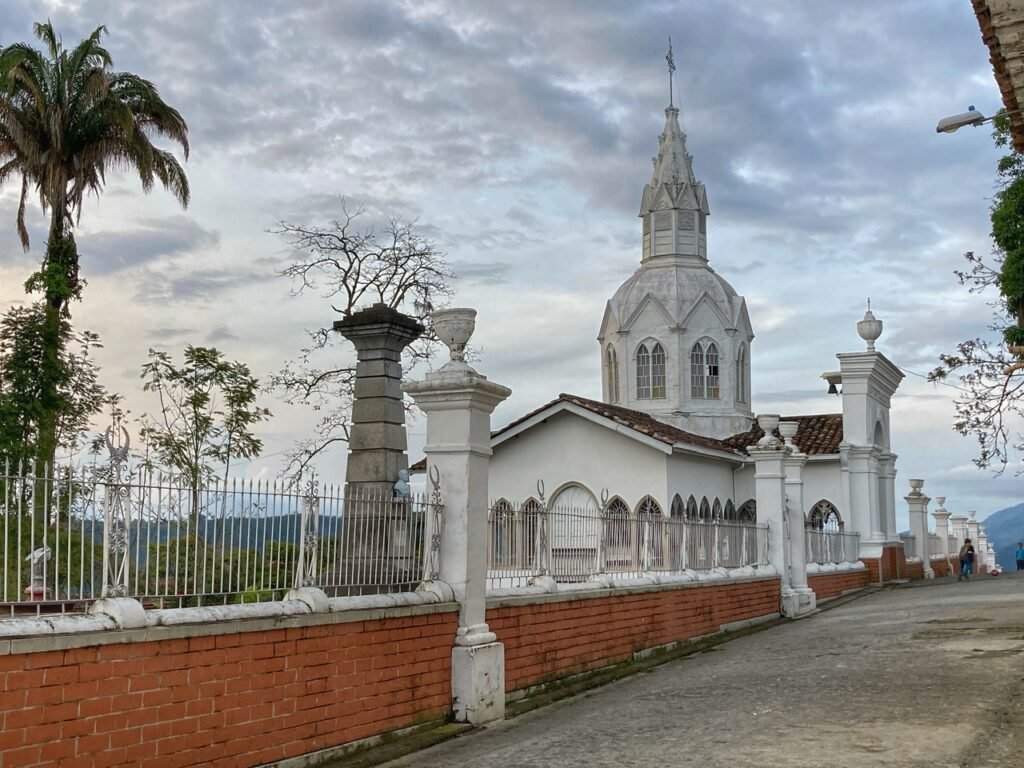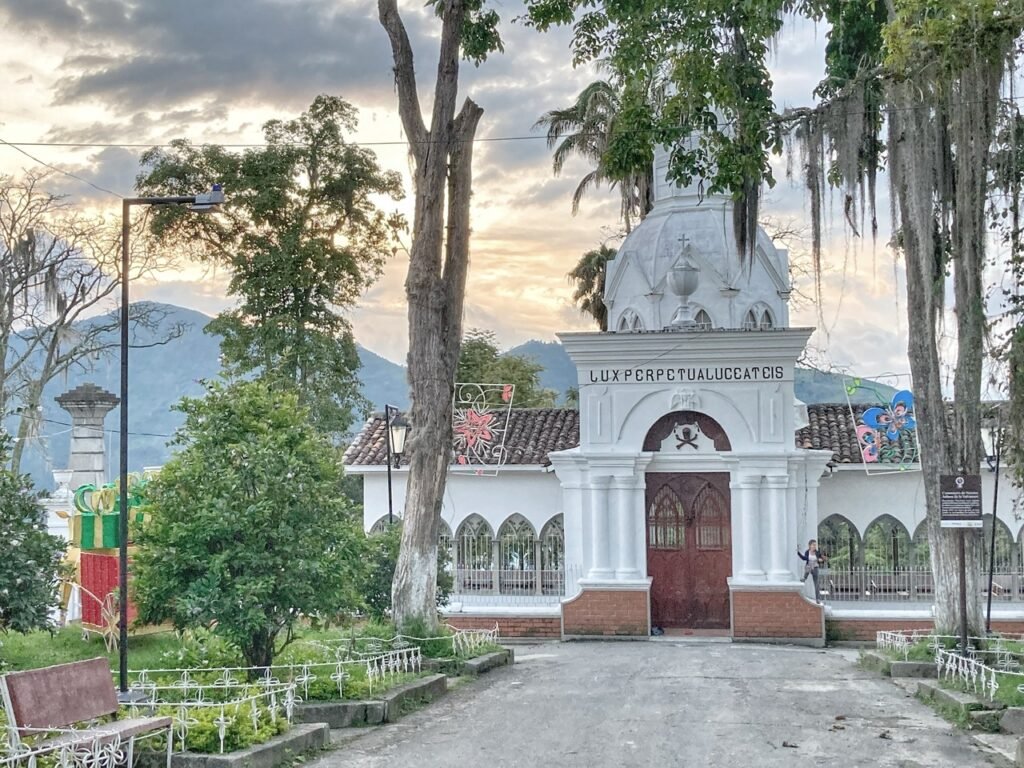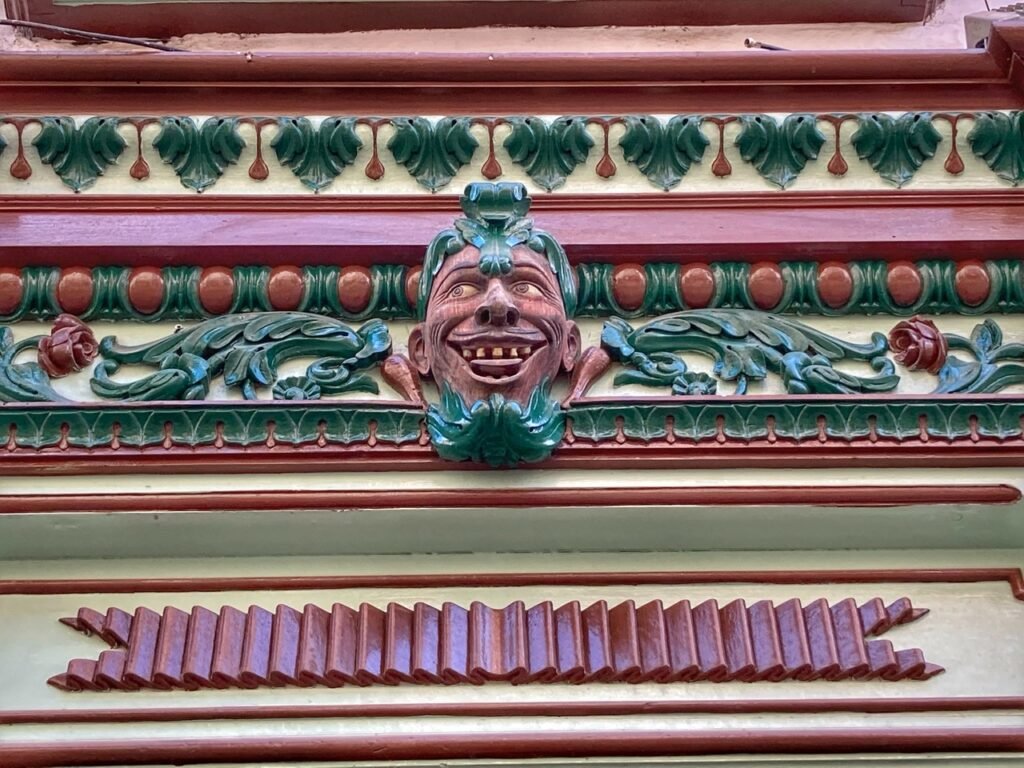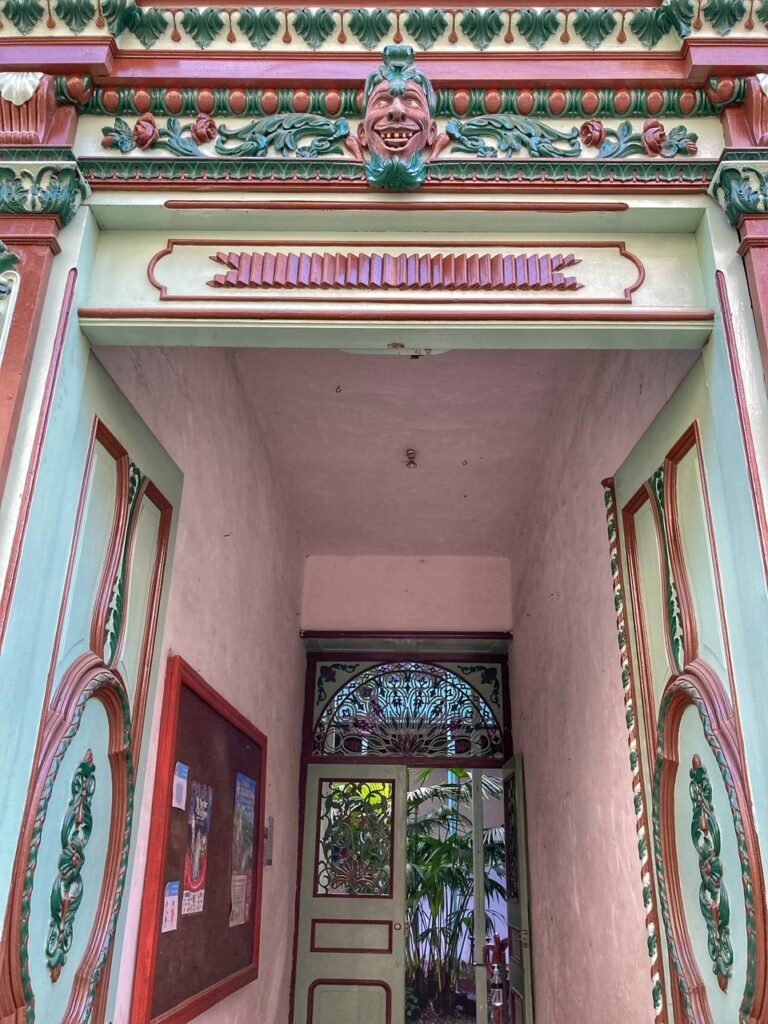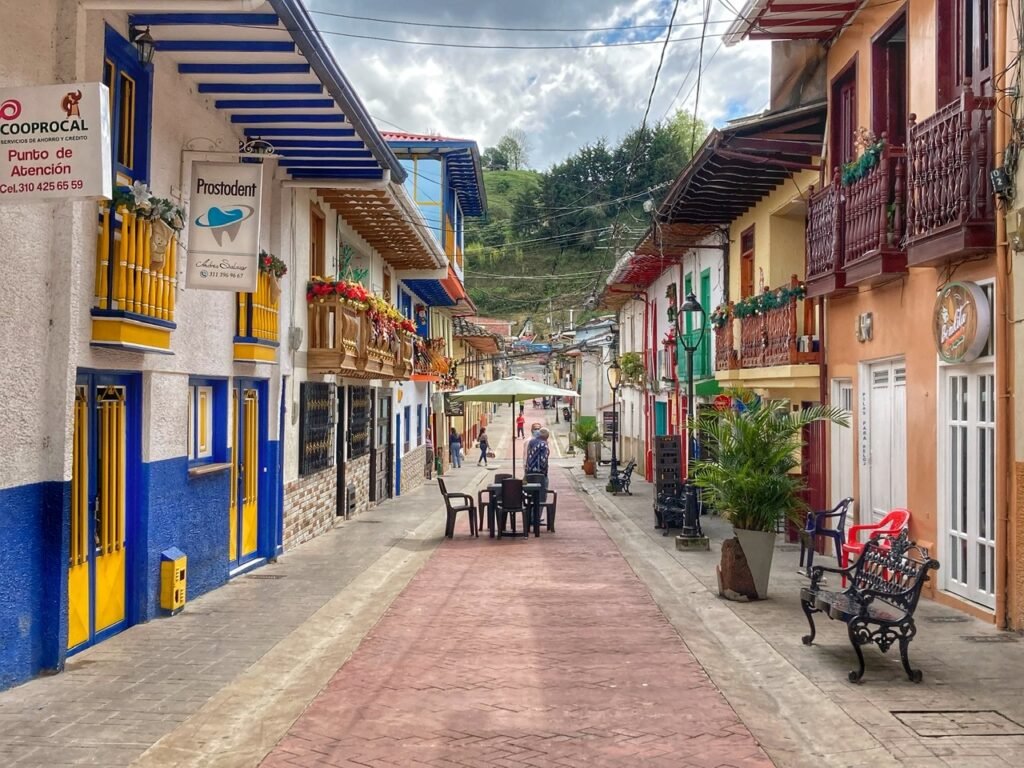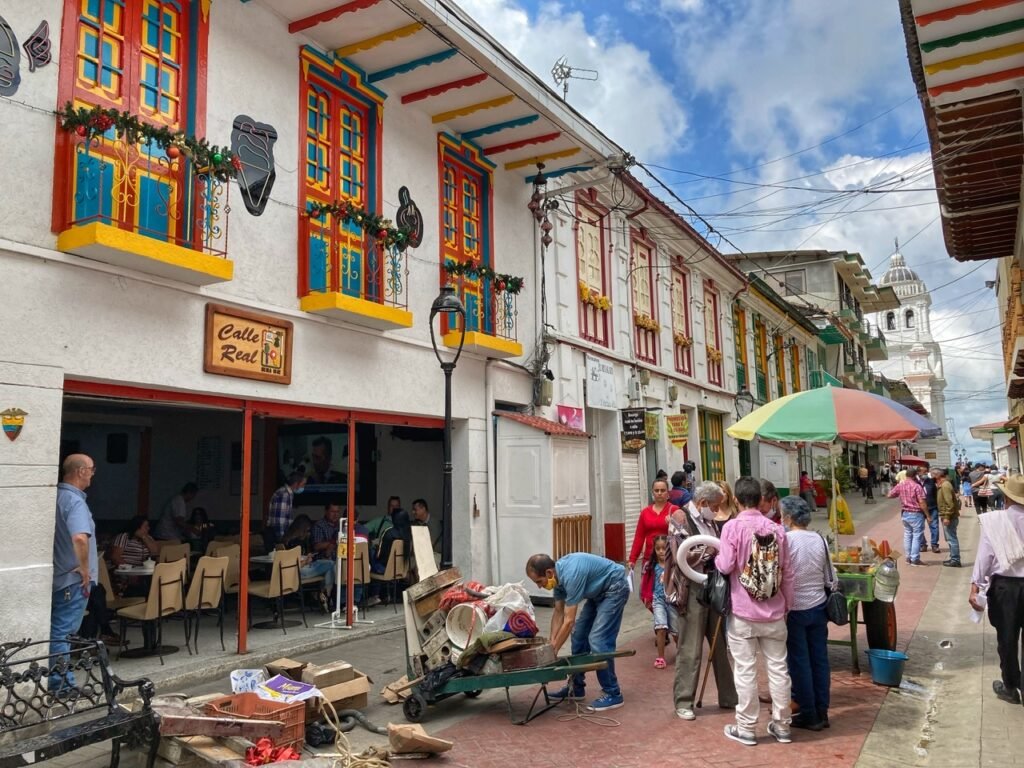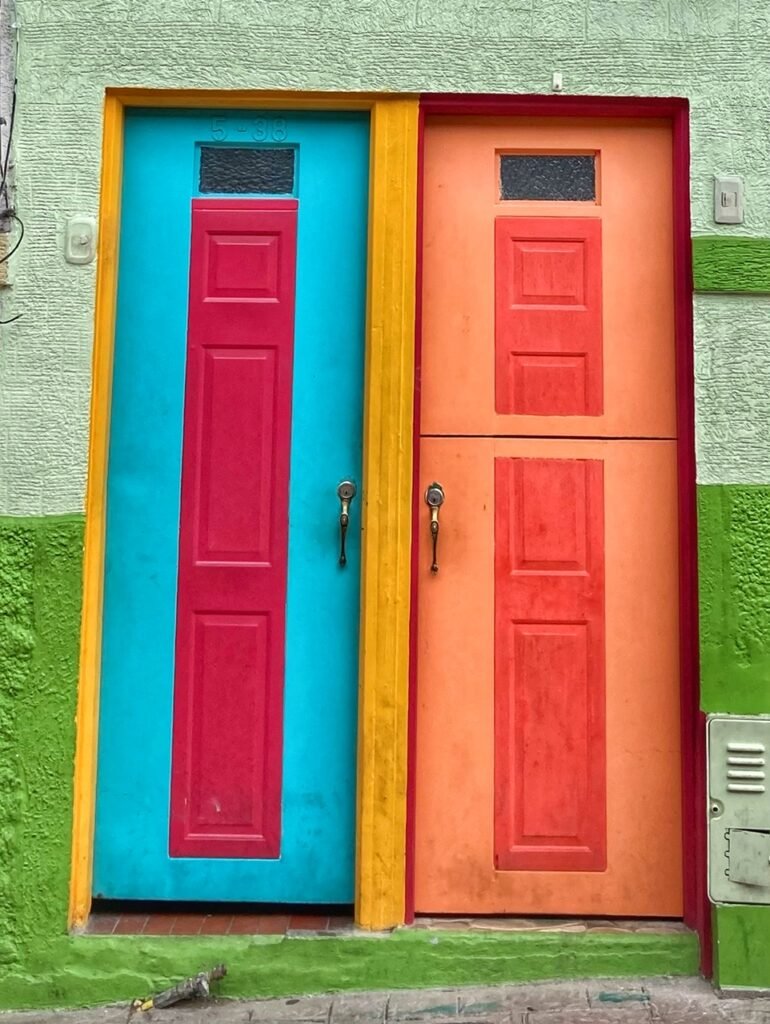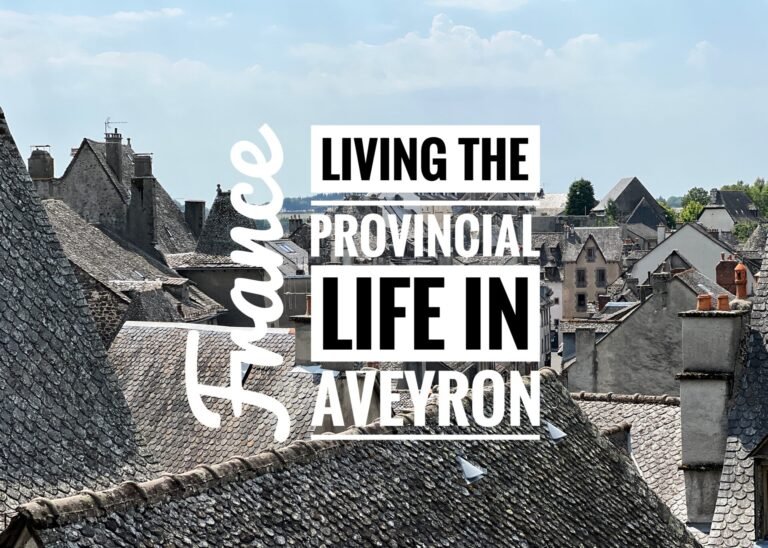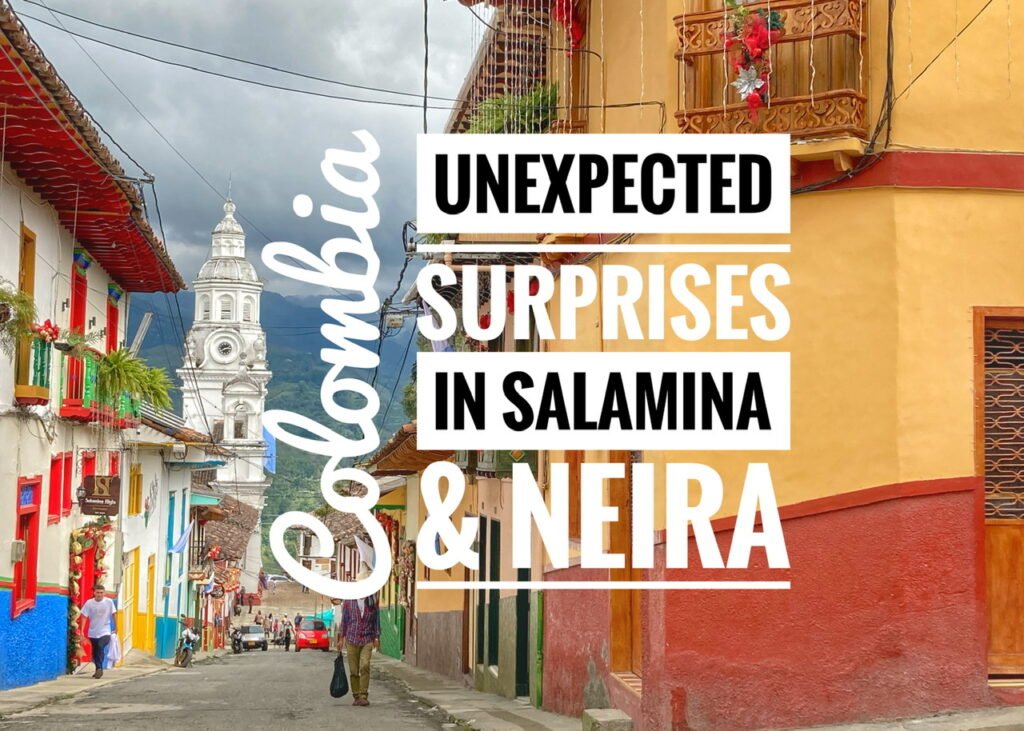
Salamina, population 20,000, is one of those little woodsy wonders that is completely off the radar for most tourists, which is exactly the reason we went on an overnight trip from Manizales. We call it a woodsy wonder because its streets are accessorized with the legacy of woodcarver Tangarife Elisha, who in the mid-19th century promoted a woodworking school that gave its seal to the town. The wood murals are extraordinary, as is the colonial Paisa architecture and colors that saturate the town’s adobe houses, businesses and Christmas decor-spritzed balconies.

The mini-bus ride was $21,000 pesos or about $5/each, and took about three hours. This time on the bus, the words “Si se marea, pida bolsa,” were etched multiple times throughout. This means, if you get sick, ask for a (barf) bag. You know if it’s permanently displayed on the windows, it’s gonna be a rough ride.
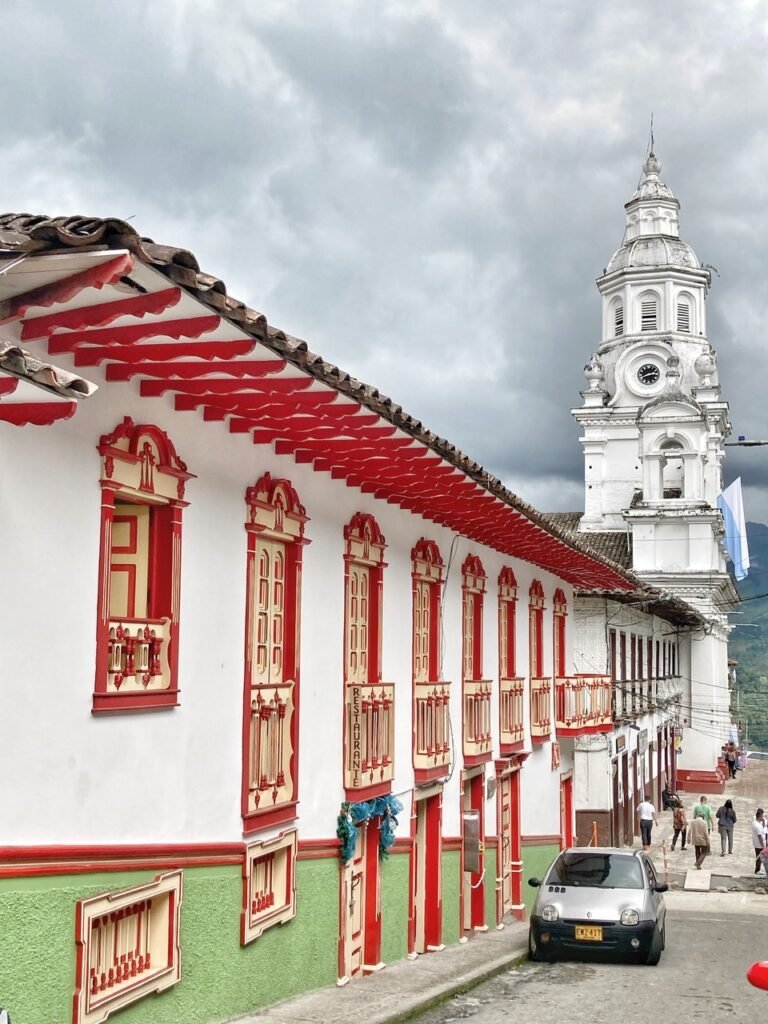
Arguably, the most jolly street in the town. Here, you expect Christmas elves to fling open the shutters and invite you in for a Peppermintini and toy-making sesh. It couldn’t be more naturally ready for Christmas if it tried.
We caught this local absorbing the beauty of one of the many wooden murals sprinkled throughout the town. This mural celebrates the many notable people including poets, musicians, actors and writers, among others, who come from the area.
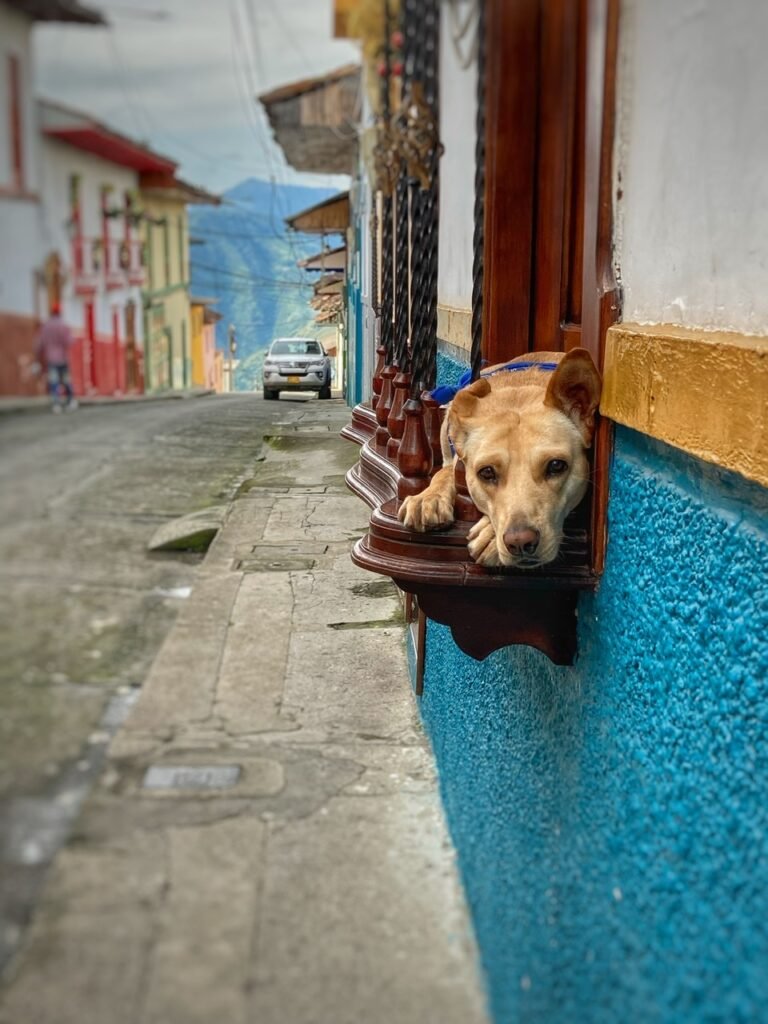
This dog isn’t really as notable, but we thought he was cute.
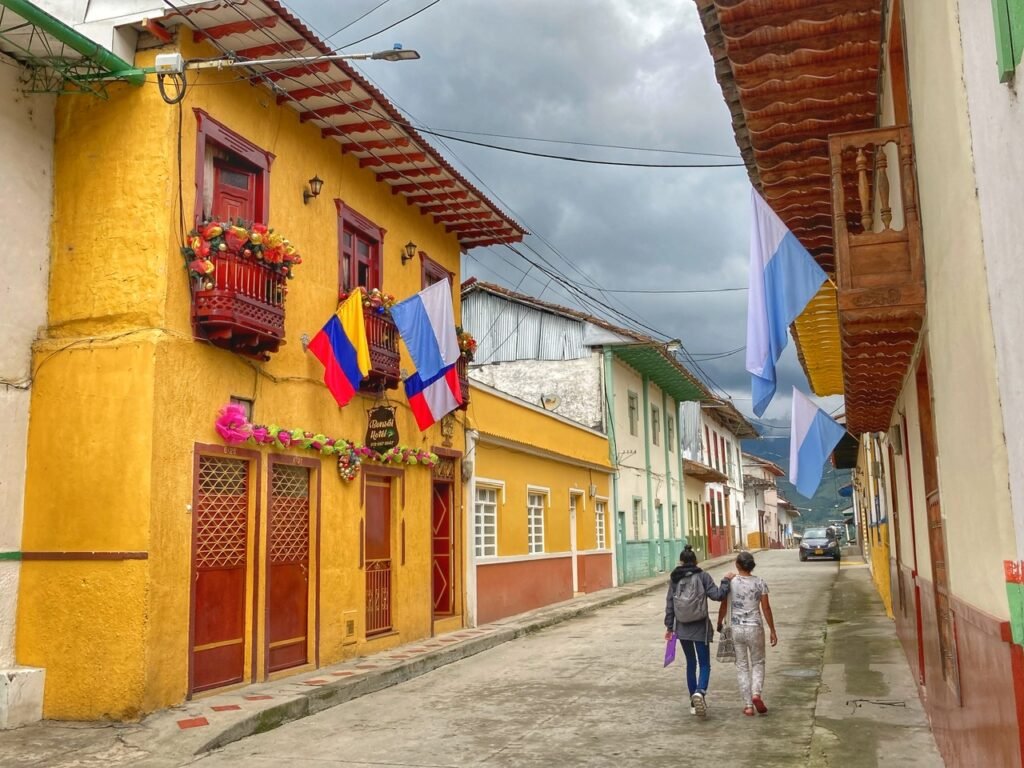
For this mid-week getaway from Manizales, we didn’t make any reservations. Instead, we decided to old-school it by rolling into town to walk around and see what kind of deal we could get. We settled on the charming Bonsai Casa Hotel, on the left with the flags.
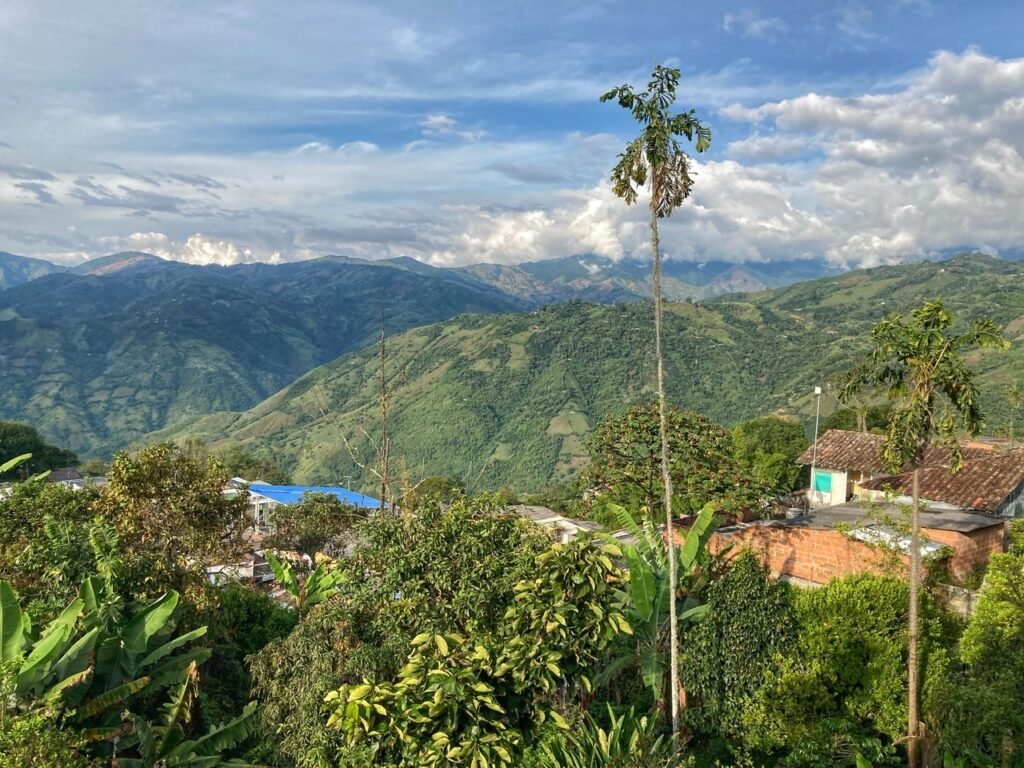
We were immediately welcomed as the only guests onto a balcony with a sublime view of the surrounding mountains, topped with a solitary wax palm candle.
And of course, we were in coffee country so it was time for an obligatory cuppa.
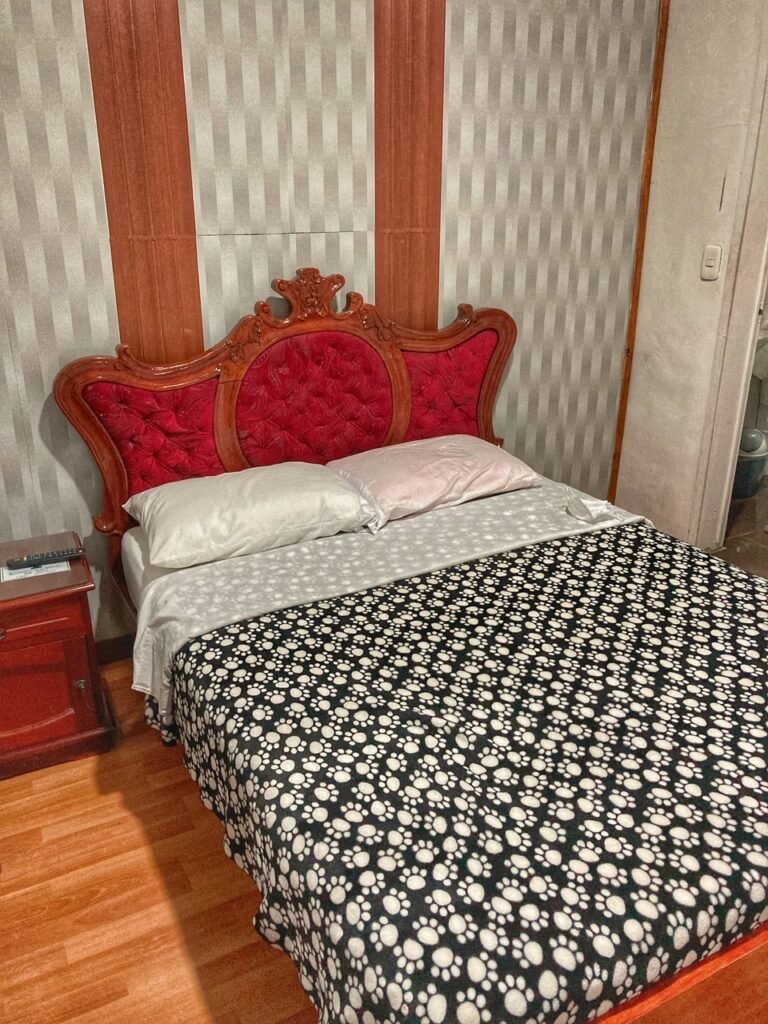
Our room for the night was simple, but comfortable, at $70,000 pesos or $17.50. Strange bedspread though. Lol.

The balcony as the clouds started rolling in.
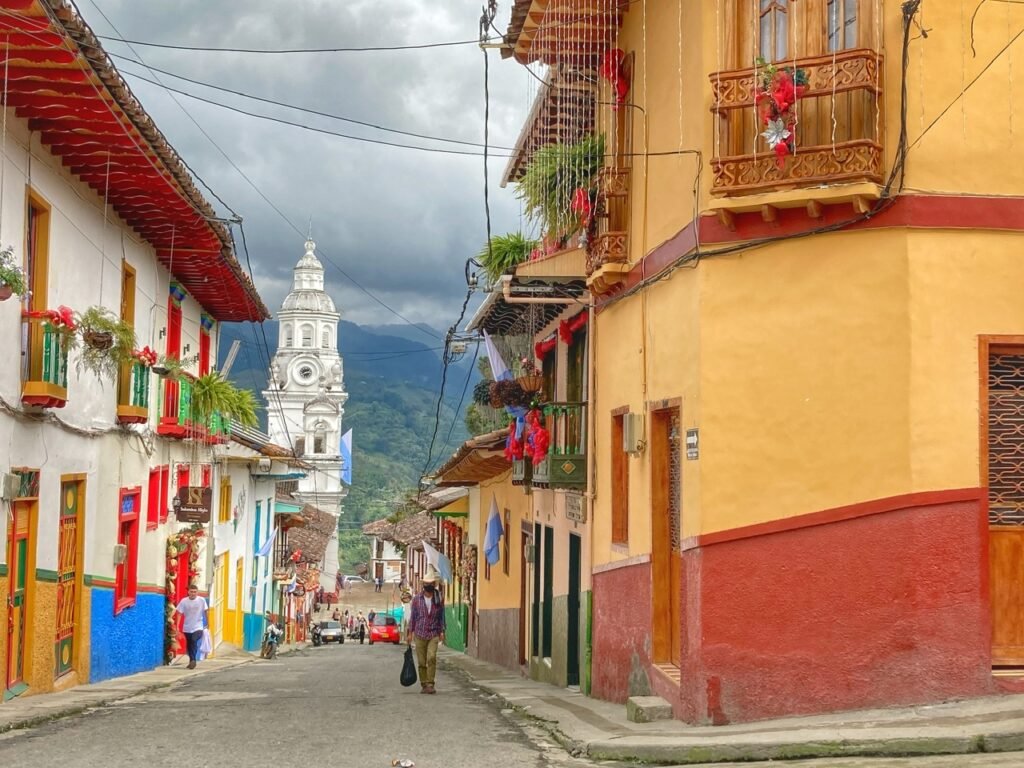
Beginning our exploration of the town.
Yes, it’s difficult to stop taking photos of this street.
Almost everyone has an upper balcony, painted in bright colors and adorned with prismatic flowers…
…or Christmas decorations this time of year. It was very common to find the Caldas flag hanging on the outside of people’s houses. Interestingly, people in Colombia seem to have a lot of pride for the department, or state, in which they live.
Some of the homes looked like they should have a permanent home at the North Pole.

One of the downsides to our visit in Salamina was unfortunately, the main square was under construction, so half of it looked like this. Not so charming, but good to know they’re making necessary renovations.

You gotta get by these little Oz-y looking men if you want to enter this beauty of Salamine architecture.

Time for lunch so we grabbed a Menu del Dia at Tres Cuartos Parilla. It was fried trout, which is getting more and more commonplace in our meals, as well as plantains, an arepa and salad for $17,000 pesos or about $3.50.
Continuing on our parade of cuteness. One thing we especially loved was the teacup windows within the doors. The hanging ferns and flower pots everywhere just add to the tranquility.
Another distinctive mural

A beautiful convent and with lovely gardens out front.

Like Manizales, Salamina is incredibly hilly. It makes it obvious why the signs are on the buses when you’re on your two feet!
In fact, half the time you’re walking it appears that the streets are about to fall off the mountain.
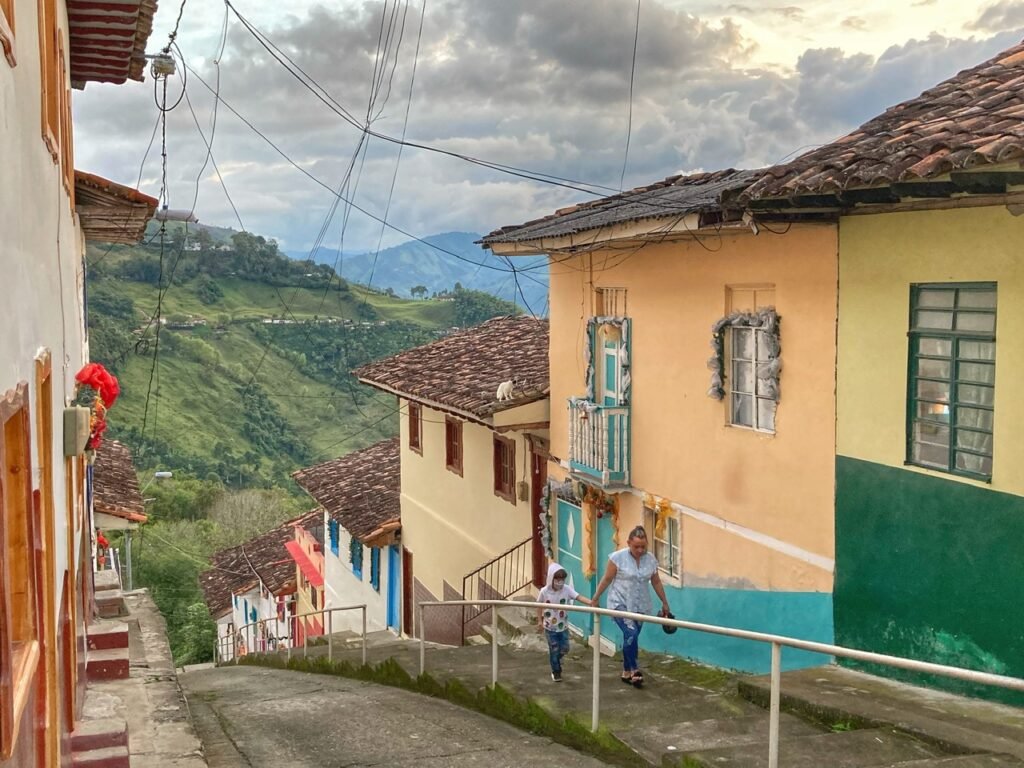
Kinda like walking on roller coaster rails.
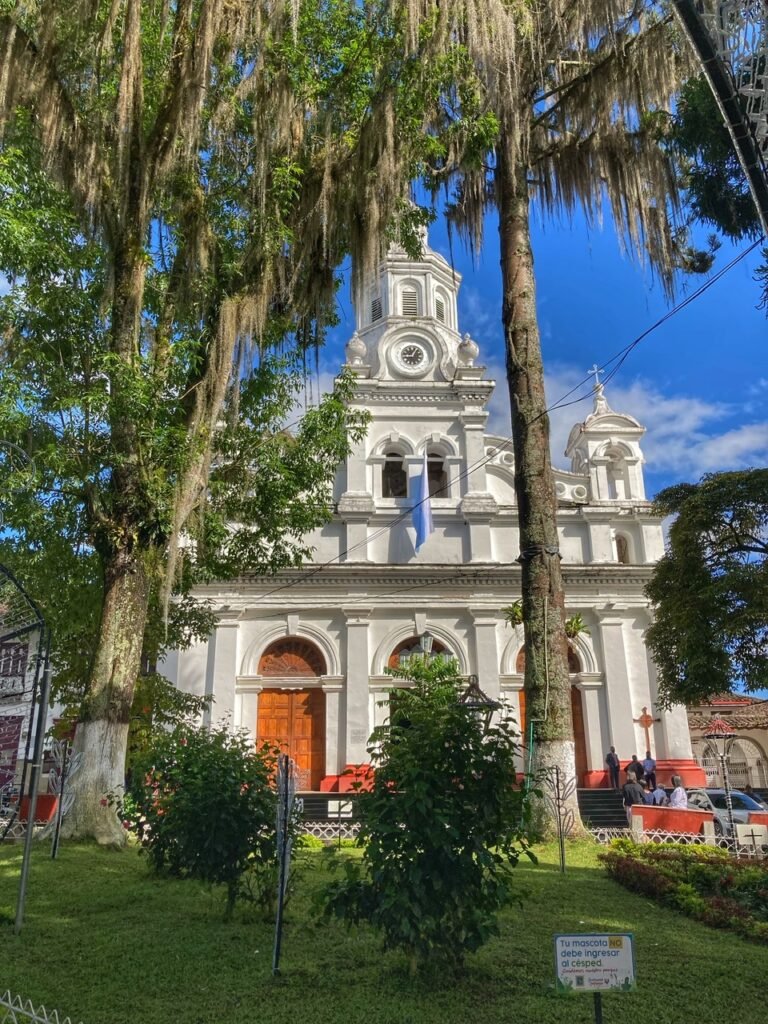
The Romanesque-style main church, Basilica Manor de la Inmaculada Concepcion was constructed in 1860.
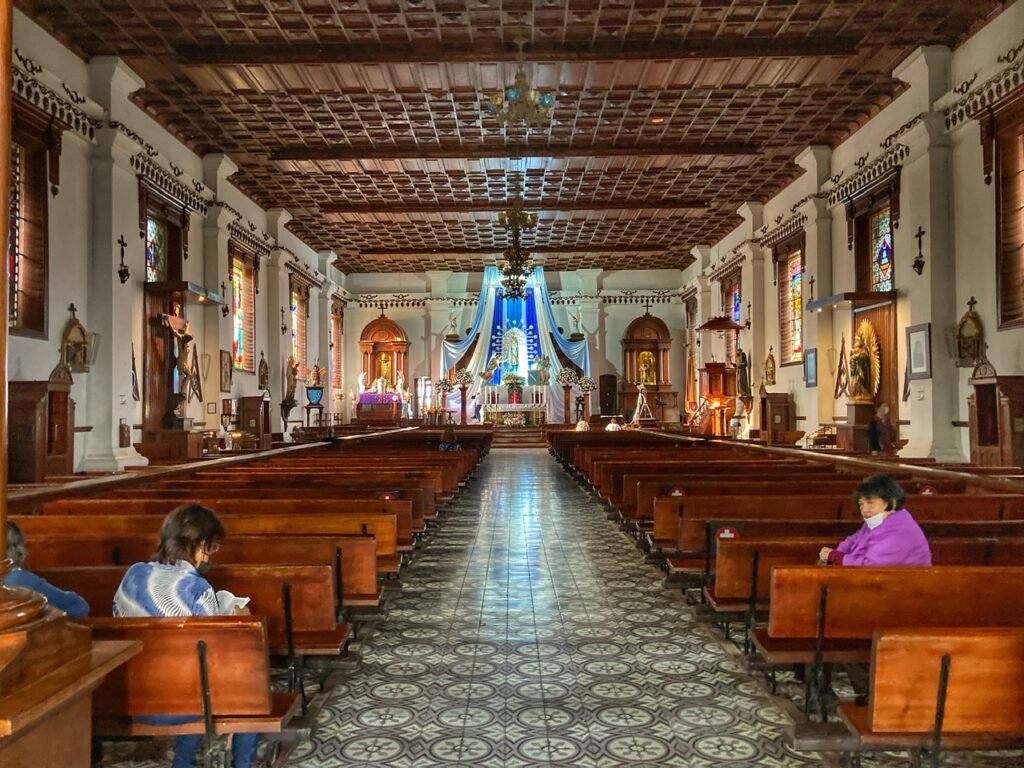
Not surprisingly, it has a vast well-preserved wooden interior with no columns.
And very beautiful stained glass.

The non-hacked up section of Parque Bolivar de Salamina, aka the main square. We sat for about an hour eating ice cream and people watching. The fountain in the main square is a replica of Blace-de-la-Concord in Paris. Some consider it the most beautiful in the Americas.

A metallic Mary and Joseph getting ready for the party.
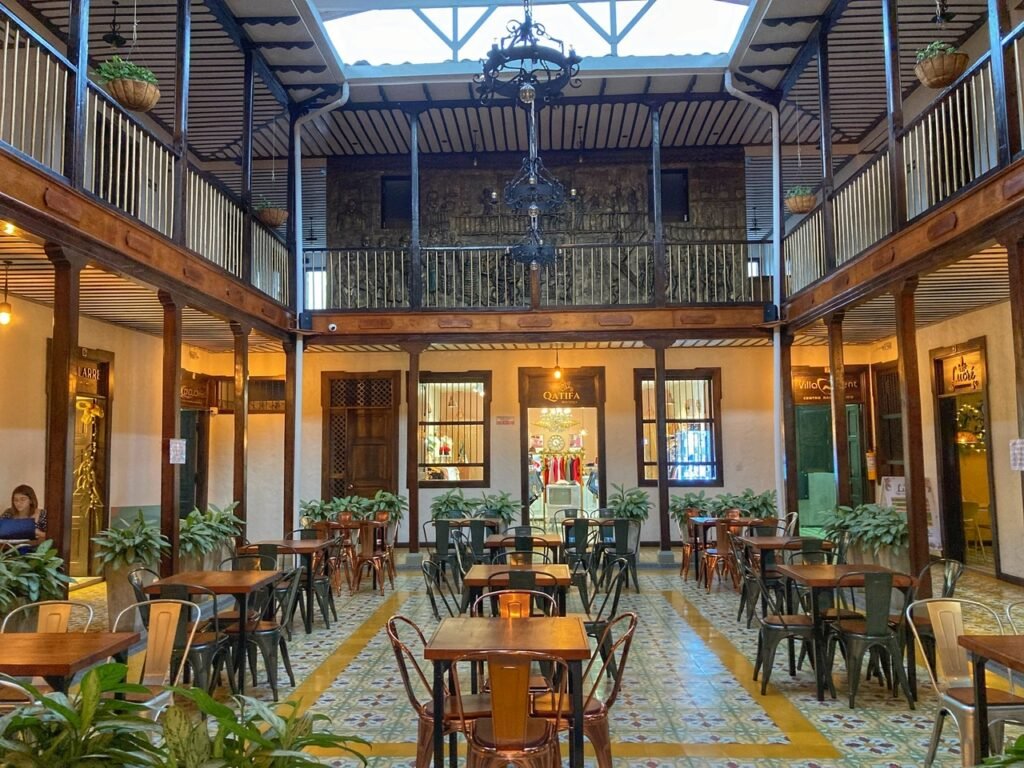
A stunning old manor house turned into a cafe and shops.
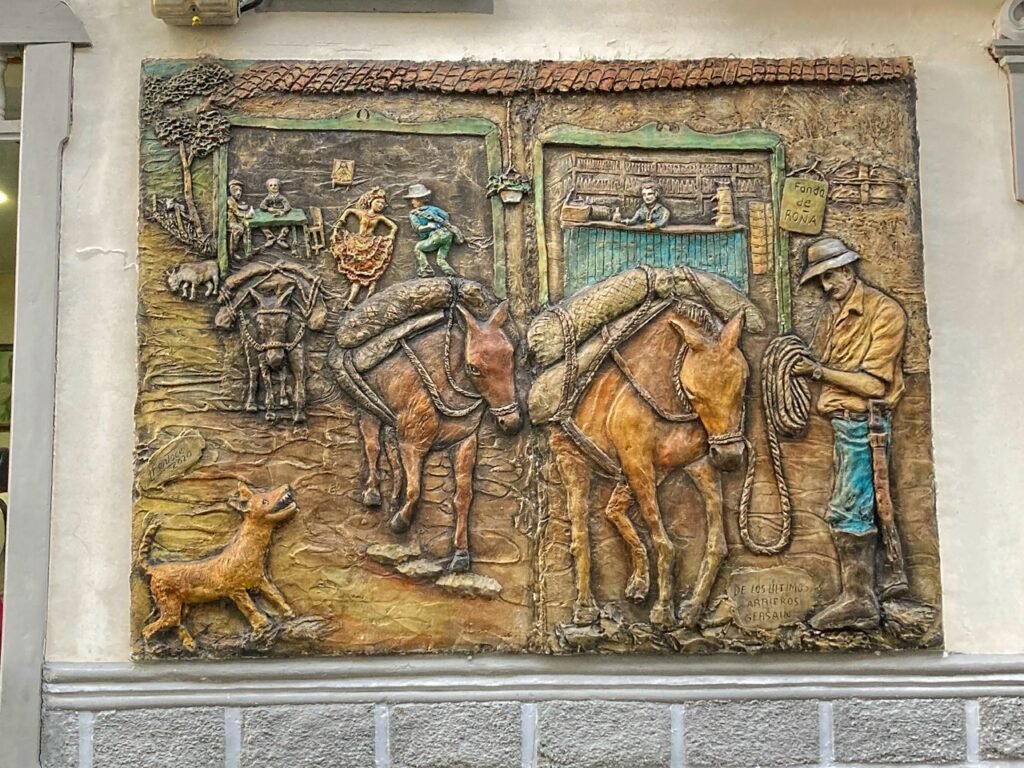
Another wood mural we discovered walking around town.
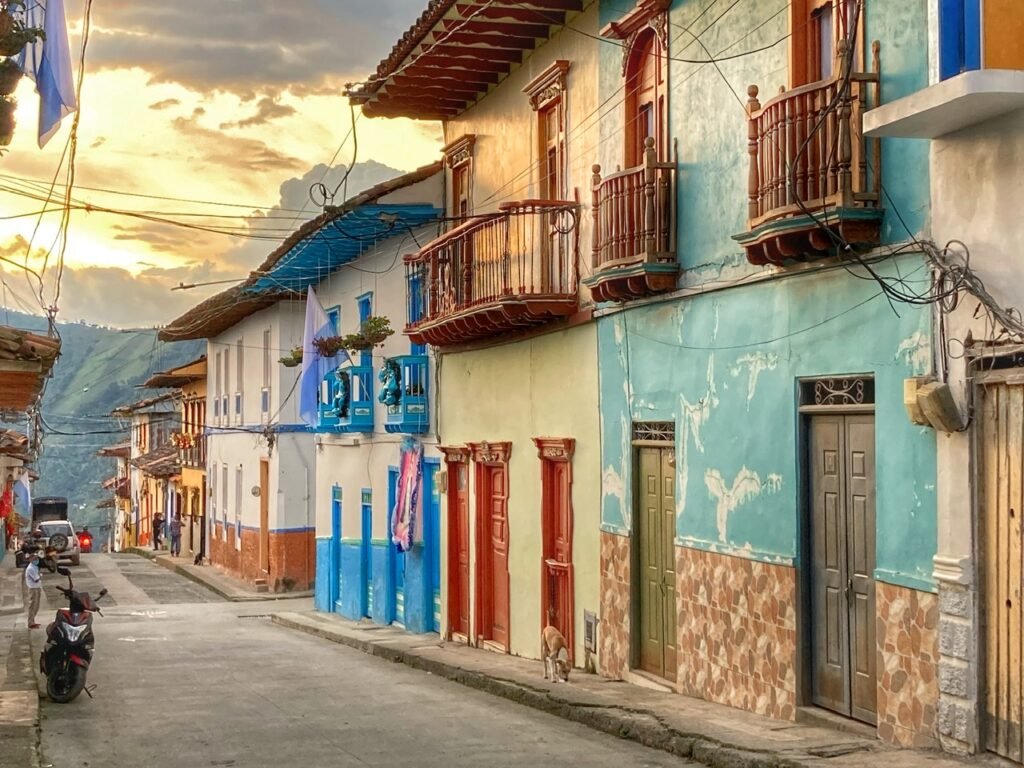
Soaking in the sunset.
The town cemetery, evidently. Not a bad place to end the day. Or, perhaps, your end of days?
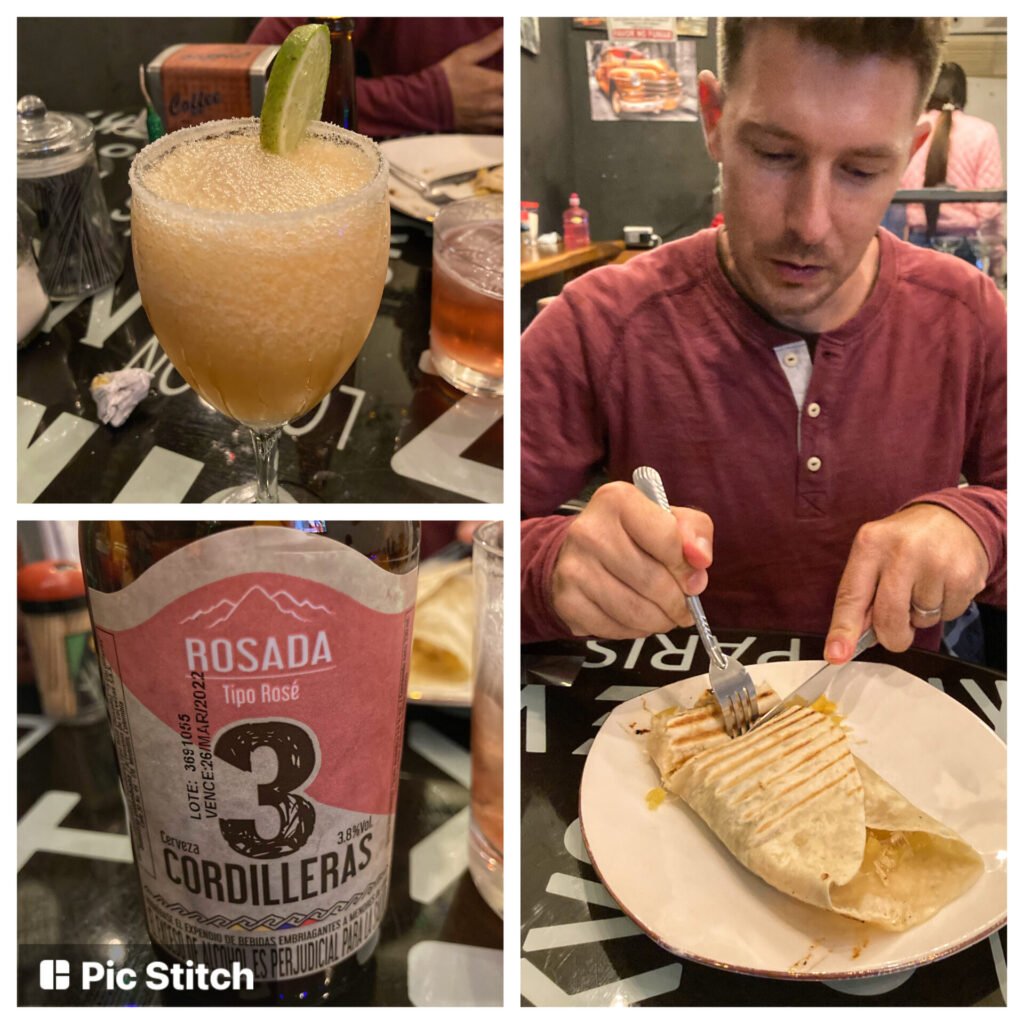
Greg was hungry so we headed to Taller Gourmet, which touted themselves as “healthy” for dinner and drinks. He had a “healthy” burrito loaded with chicken and cheese for $4000 ($1). We also indulged in a very tasty margarita, and a craft “beer” in rose flavor. Also “healthy.” Geez! Good thing we cook in most of the time! The entire meal was $15,000 pesos with tip. Less than $4.
While there, we also got to indulge in a Colombian teenager adorably trying to sing Adele along with a video on TV to his girlfriend. Except he pronounced her name Adel-eh, as you do in Spanish.
After dinner, we came upon a fun celebration. Colombia has an covetable calendar of 18 paid public/bank holidays throughout the year, the second most in the world after Argentina (19). Not to mention, they also host a plethora of “bonus” celebrations. There seems to always be a reason to party, or honor a random Saint.
Therefore, it’s not surprising on a serendipitous Wednesday (November 30) we managed to stumble upon yet another jollification in the tiny pueblo of Salamina…St Andrew’s Day, which is predominantly a Scottish holiday, but apparently Colombia wanted some of the St Andy action as well.
St Andrew was one of the 12 disciples of Jesus Christ, and the brother of the Apostle Peter, who introduced him to Jesus. In Scotland, where evidently it’s a big deal, people celebrate this day by gorging on Cullen skink – a type of fish soup – or lamb. Here in Colombia, we witnessed an evening procession from the main church of Salamina which followed a statue of Saint Andrew to an mystery destination. And fireworks. Of course. Because there’s always reason to blow up fireworks in Colombia.
The next morning, we spied what appeared to be a jester over a doorframe inviting us into yet another alluring old manor courtyard.

Grabbing a coffee with the locals. $2000 pesos or $.50. And it was DELICIOUS.

While enjoying the coffee, we also had a random visitor. He belonged to a guy who was literally giving a (paid) massage to another dude in the back of the restaurant. After the massage he came to introduce himself using the oily paw he had just been doing the rub-down with, and then scooped up his rabbit, bizarrely named Rico, (which often means delicious in Spanish), so Mandy could pet him. Now that’s an interesting fellow.

The economy in Salamina is based on coffee, and raising livestock and dairy, so why wouldn’t you nearly trip over coffee beans out on the street drying in the sun?
A Chance Encounter of Neira, Colombia

After visiting Neira, we are absolutely convinced that every pueblito in Colombia offers something. We only ended up here after being unable to go to our preferred destination of San Felix to see wax palms after Salamina. We stopped off in this randomly selected village, which is about 35 minutes north of Manizales by mini bus or Jeep. And sure enough, although a tourist, local or otherwise, may have never set foot in it, like so many others, it was pleasant, colorful and absolutely charming.
The town was actually named part of the “Coffee Cultural Landscape” UNESCO World Heritage Site in 2011. The town square was very picnicable for our blueberries, yogurt and tuna which we compiled from D-1, the go-to backpacker supermarket in Colombia. Love that store. It was either eat this, or bandeja paisa and fried chicken. Our only gripe in Colombia is the lack of healthy food. Ah, well. You can’t have it all!

Colors of Neira. We love the subway-style tiles in this scene. Very unique.

A common sight in this part of the country. Tons and tons of arabica coffee beans, mostly heading for export to your Starbucks cup (among others) in the United States, Europe (led by Germany), and Japan. Colombia is the second largest coffee producer in the world, after Brazil. Colombia is classified as an upper middle class economy, in part due to this magical bean.

The main pedestrian thoroughfare in Neira.
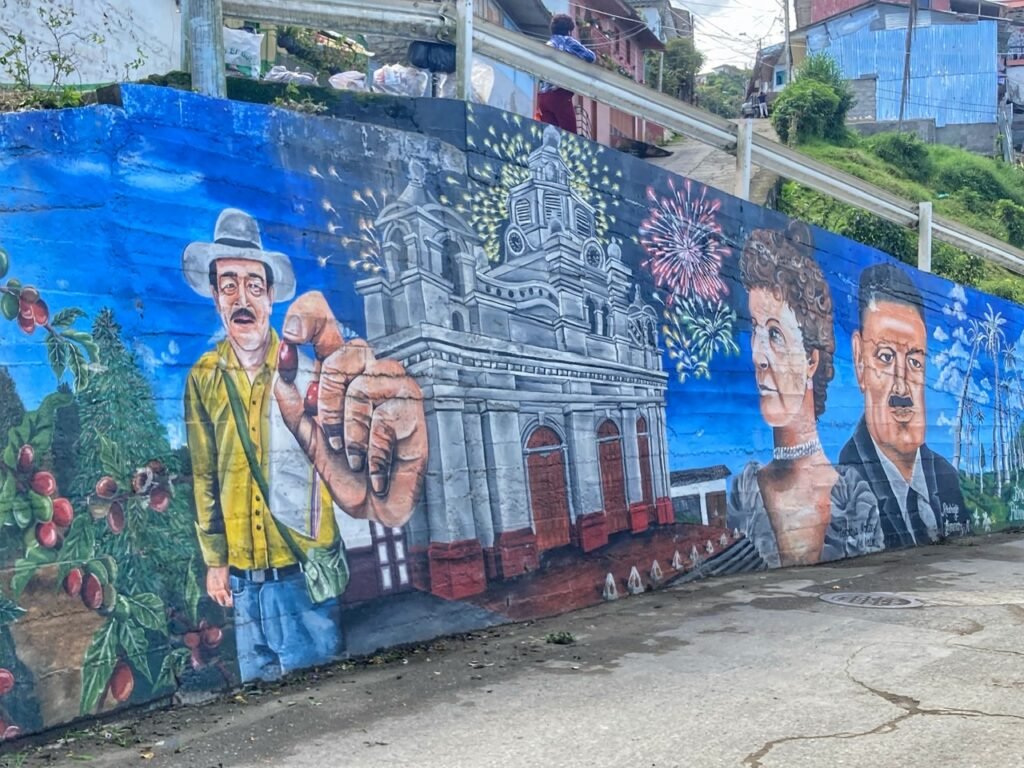
A mural which completely captures the area including a guy plucking coffee cherries.

Jeeps, jeeps. So many jeeps. This is a common way people get around here due to the rough mountain terrain.

Part of the main square. Looks like a typical Colombian town.
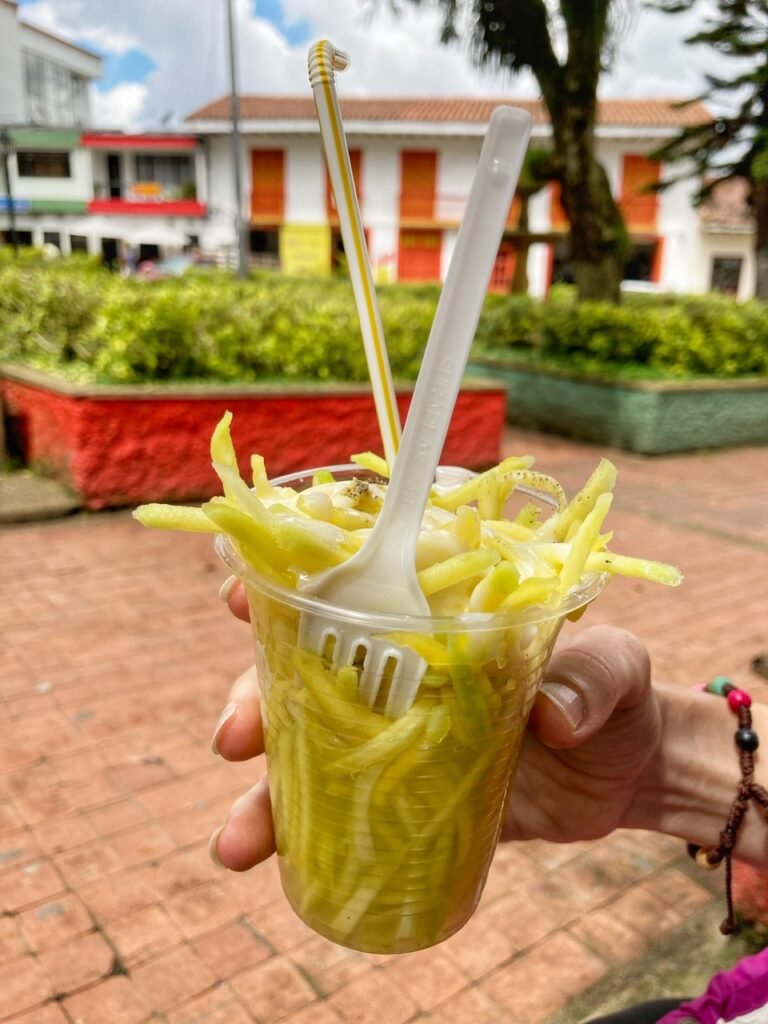
As we searched for healthy food options, we finally tried our first Mango Biche in Neira. A Mango Biche is a common street snack consisting of green unripe shredded mango, resembling noodles, topped with salt, lime and in this case, what appeared to be condensed milk. Although mangoes on their own are already delicious, these additions were surprisingly scrumptious. Cost was $2000 pesos or $.50 per cup.
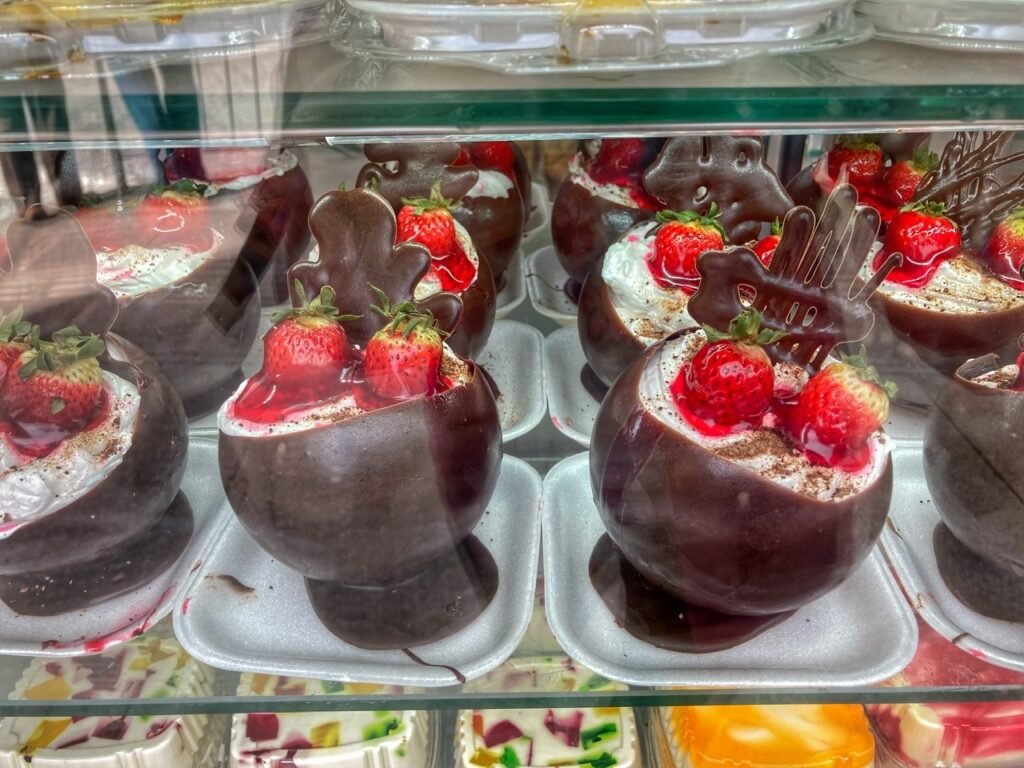
Good thing we had the mango biche before we saw these. Yum. We love that strawberries are always in season in Colombia?

Just a lazy afternoon at Cafe Wilson.
Street scenes Neira. Parts of it were was buzzing with daily activity.
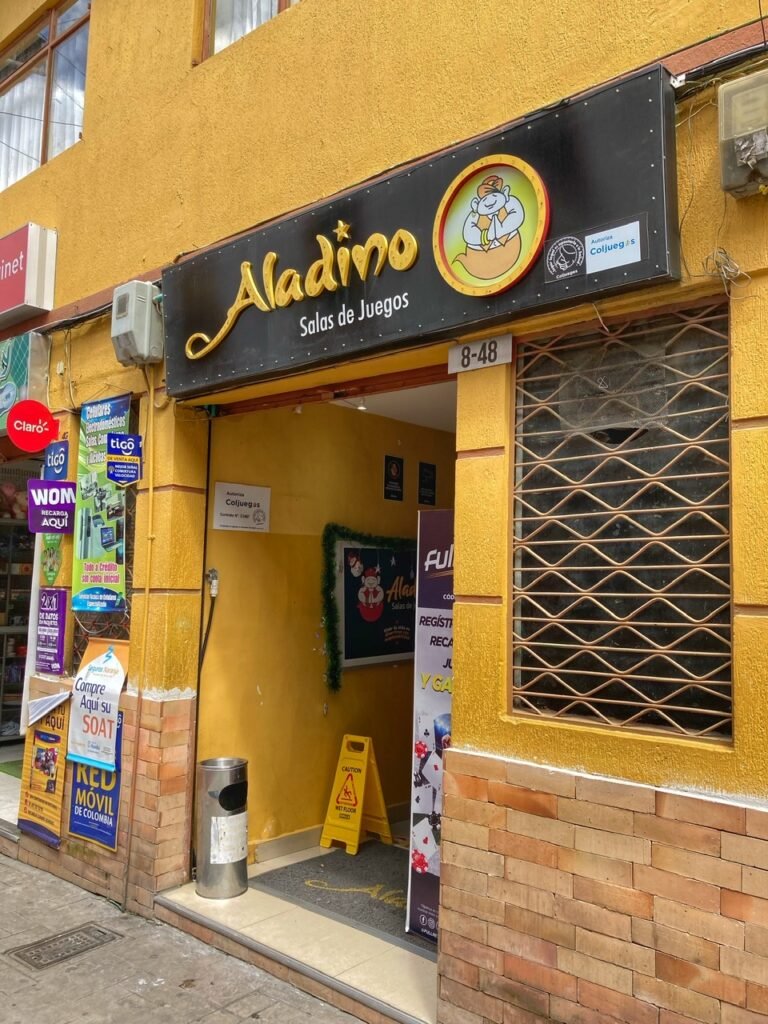
And like all Colombian towns, they also had lots of options for gambling. We had no idea that Colombians were such risk-takers.

Loved the Christmas colors on this facade.
Balconies similar to Salamina and accentuating crayola colored doors. Love seeing the life in these towns. It feels so genuine and although we got a few curious looks, everyone was incredibly kind and welcoming as with everywhere else in the country.


